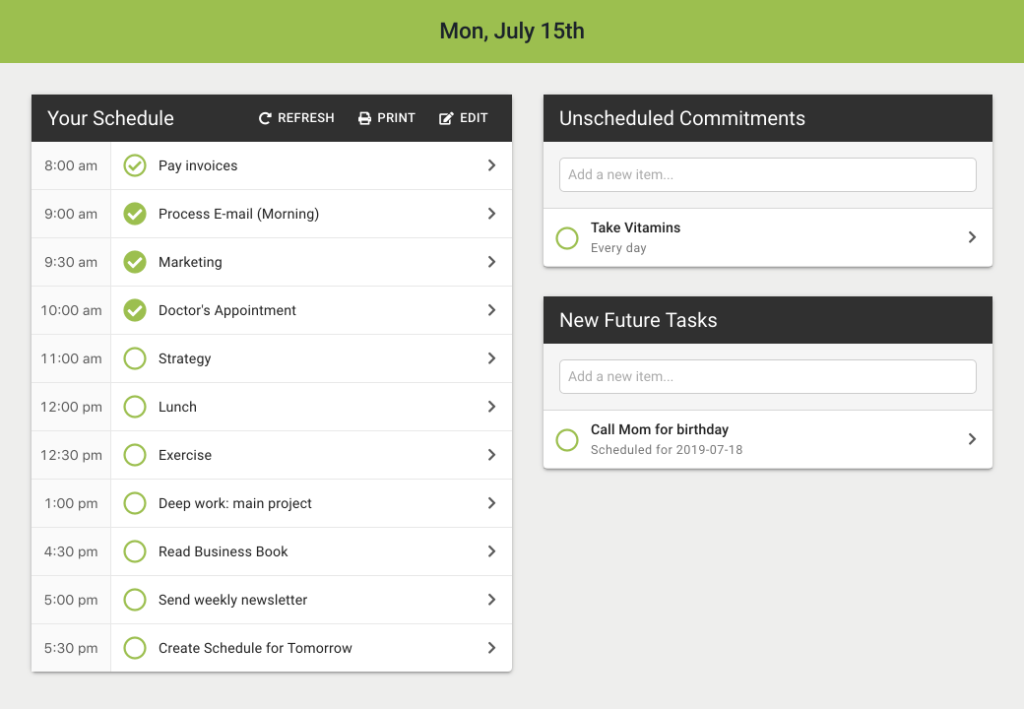Attention-Deficit/Hyperactivity Disorder, more commonly known as ADHD, is a neurodevelopmental condition that can significantly affect an individual’s ability to organize tasks, manage time, and maintain productivity.
For people with ADHD, to-do lists can often become an endless source of frustration rather than a helpful tool. This article will explore how to make your list of daily tasks more ADHD-friendly, turning them into an effective ally in achieving your daily goals.
Understanding the ADHD Brain and Organization
ADHD is characterized by symptoms such as restlessness, impulsivity, and difficulty maintaining focus. These traits can make traditional organizational methods less effective.
For instance, a regular to-do list might be abandoned because it feels overwhelming, too rigid, or simply not compatible with the ADHD brain’s way of processing information.
But a to-do list can be tailored to better suit the unique needs of individuals with ADHD. Let’s find out how…
Creating an ADHD-Friendly To-Do List
To create a to-do list that works for ADHD brains, we need to start with the basics.
Break Individual Tasks Down
When a task is too large, it’s hard to know where to start. Take these larger tasks and break them down into a list of smaller action steps. This helps reduce feeling overwhelmed with these larger tasks.
How to do this?
Ask yourself whether a task can be done in a single time block? If not, break the task down into smaller parts by asking yourself what is the first and last thing you need to do for the task.
Once you have the first and last thing, brainstorm the other sub-tasks you’ll need to get the task accomplished. Put these smaller tasks on your to-do list instead of the larger task.
Prioritize Your Daily Tasks
Not all tasks are created equal, so it’s important to distinguish which ones are critical tasks that need immediate attention, which ones are essential tasks that are not urgent but still important, and which can go back on your backlog for another day.
A few prioritization strategies that can help include:
- Divide & Conquer
Assign each task a priority of High, Medium or Low. If you have too many tasks in a single category, repeat for that category (e.g., High-High, High-Medium, High-Low). - Least Important First
Instead of trying to figure out what is most important, ask yourself what is least important and either remove that or move it to the bottom of the list. Figuring out what is less important is usually easier and you’ll have fewer remaining items to prioritize. - If Not This, Then That
Ask yourself what the consequences are if you don’t do the task at all, or if you do the task late. Often we imagine things to be more important than they are—forcing ourselves to be explicit about the consequences can help us figure out what is truly consequential.
To learn more, check out 7 Techniques for Prioritizing Your Tasks.
Use Specific Language
Instead of writing “clean the house”, break it down to “vacuum the living room” or “wash the kitchen dishes”. This prevents vagueness, making it easier to start tasks.
Also, try to start each of your tasks with a verb. Don’t write “Dishes”, write “Wash the dishes”. Using a verb at the beginning reminds you that these are things to do, and immediately tells you the action required to accomplish the task.
Assign Time Allocations
Give each task an amount of time that you plan on working on it today. This may be a time estimate for how long it will take to complete or just the amount of time you want to spend on the task today.
Time allocations can help provide a more realistic view of what can be achieved in a day and help with planning.
Making Your List of Tasks Visually Engaging
Visual appeal isn’t just about aesthetics—it’s a powerful way to engage the ADHD brain.
Try color-coding items by priority or task type, or using emojis 🔥 in your task titles to make the emotions and specifics of tasks easy to identify.
If you are using a digital planner like Day Optimizer, watch this video on how use emojis in task management apps. If you prefer managing your tasks on a piece of paper, use highlighters and doodles to make your list more engaging.
When possible, use checkboxes or strategies like Done Today vs Done Forever to give you a sense of accomplishment as you work on items throughout the day. Checking things off your list will give you a small dopamine hit that can help you build motivation and momentum.
Incorporating Breaks and Rewards in Your To-Do List
Breaks and rewards are crucial for people with ADHD as they can have difficulty focusing for extended periods.
Incorporate regular, short breaks into your to-do list.
Write down “5-minute break” or “15-minute nap” on your to-do list to remind you to take these breaks. You’ll also get the benefit of that small dopamine hit I mentioned in the previous section when you check these off.
And don’t forget to reward yourself!
For particularly challenging tasks, write a reward in the title or notes of the task. Whether it’s a short walk, a favorite snack, or a few minutes on a fun game, rewards can significantly boost motivation and give your brain a chance to rest and reset.
Leveraging Digital Tools for ADHD Daily To-Do Lists
With the advent of technology, there are now countless task & time management apps designed to help manage tasks and time more effectively.
Daily planner apps like Day Optimizer can help you plan your day using guided workflows, guiding you from the initial brain dump of a list of tasks to creating time estimates for each task and assigning them into time slots in your day.
Other top-rated task management apps include Todoist, Trello, and Asana. Explore different options and see which one resonates best with your personal style and needs. While some of these may require an app purchase, the benefit you’ll gain from the additional features these apps provide over pieces of paper will make it worth it.
Using these organizational tools can help you tame your list of tasks by creating task lists on a daily basis—which can help improve your time management skills and your everyday life.
Staying Flexible and Regularly Updating Your Daily List
People with ADHD often experience fluctuations in their energy and focus levels. Hence, it’s essential to keep the to-do list flexible.
If something isn’t working, adjust it. If a task takes longer than expected, move other tasks around.
Unfinished tasks? Copy them over to you daily list on the next day.
Decided that a task feels too much to get to today? Mark it “Skip Today” so you can ignore it for the rest of the day.
Regularly updating your to-do list ensures it remains a practical and useful tool rather than a source of stress.
Conclusion
Making an effective to-do list for an ADHD brain might require some extra steps and personalization compared to a traditional list.
However, by focusing on breaking tasks down, prioritizing, using visual cues, incorporating breaks, utilizing tech tools, and maintaining flexibility, your to-do list can become a powerful tool for enhancing productivity and reducing daily stress.
Start exploring these strategies today, and experience the difference an ADHD-friendly to-do list can make in your life. Your unique brain deserves a unique approach to organization and productivity.








